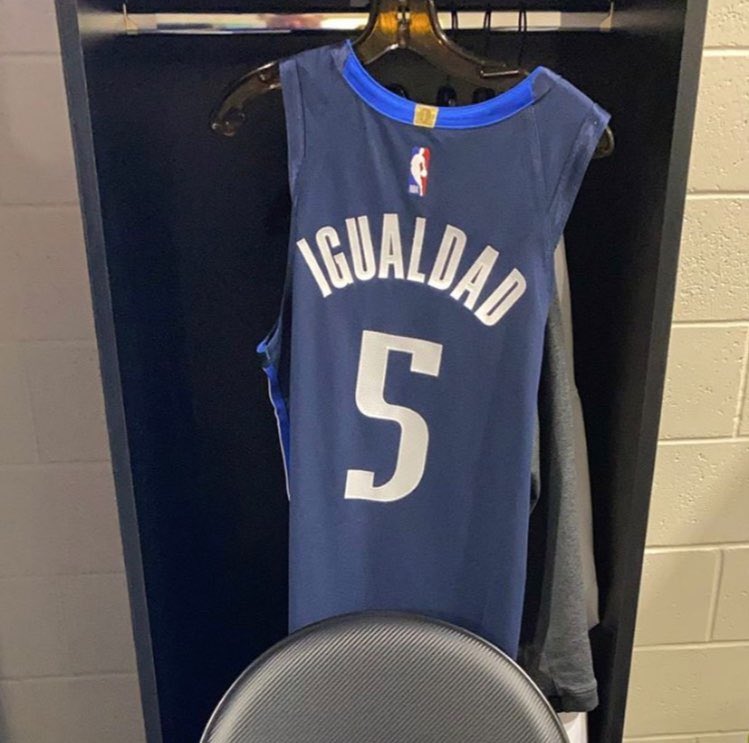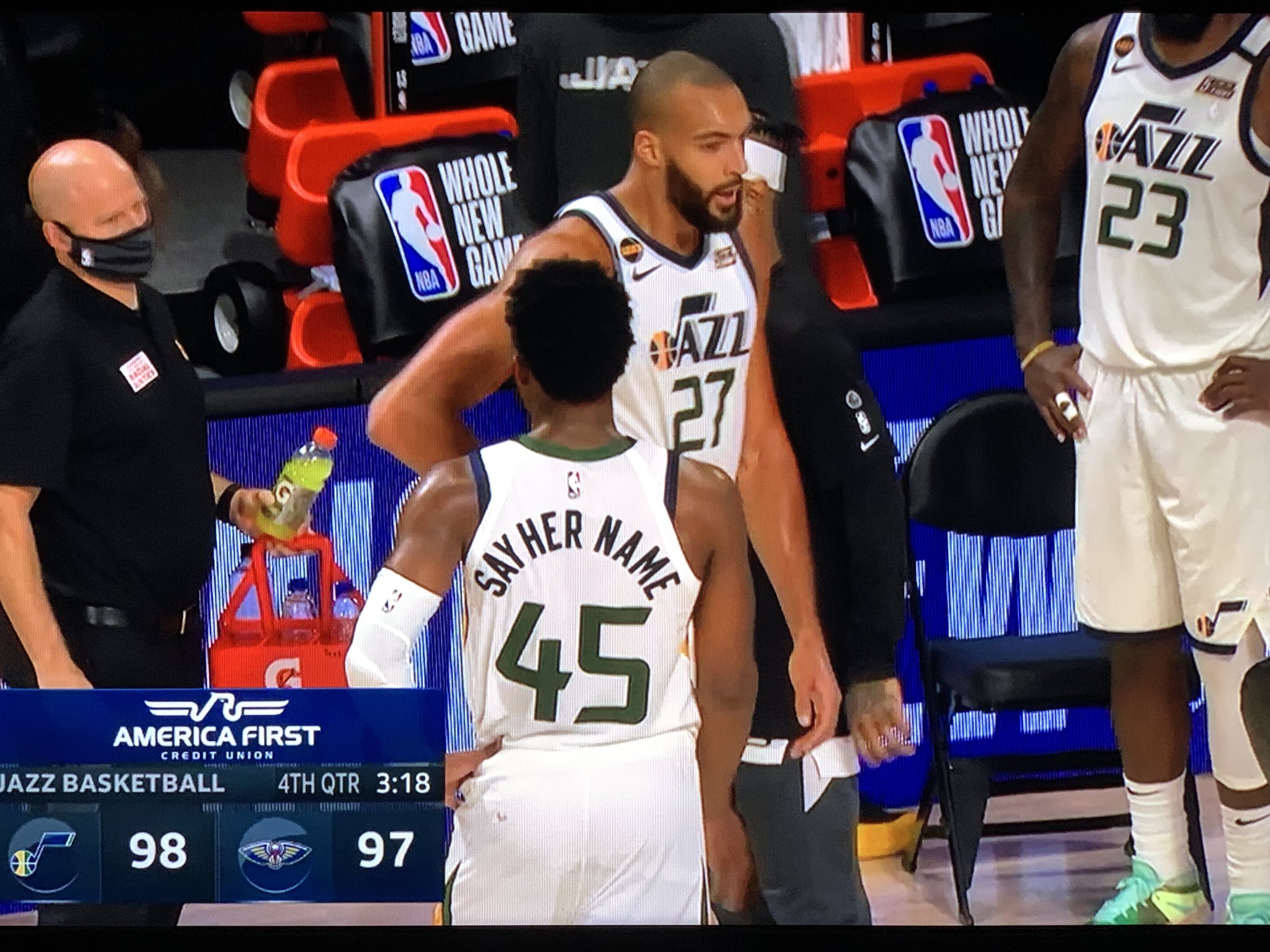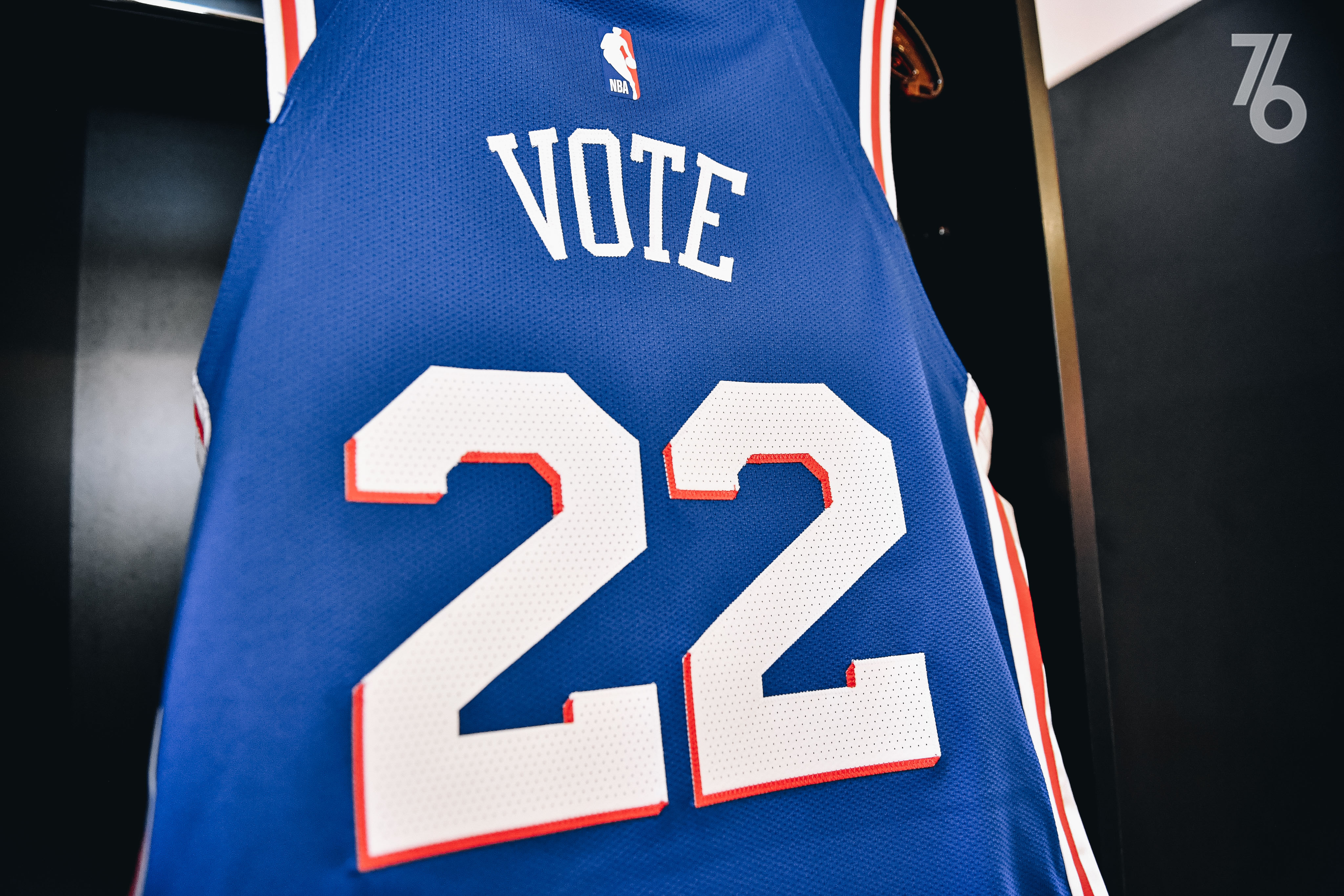By Alyssa Goldstein Sepinwall
The eighteenth century can seem remote to students interested in 21st-century issues. Especially in 2020, amidst the COVID pandemic and the explosion of #BlackLivesMatter protests following the murder of George Floyd, it may seem challenging for students to focus on long-ago subjects like the Enlightenment and the Age of Revolutions.
First look at NBA players wearing social justice messages on the back of their jerseys. pic.twitter.com/g34t41cRRx
— ESPN (@espn) July 30, 2020
I would argue, however, that the 2020 summer basketball restart is an ideal means for helping students connect the present to the eighteenth century. The social-justice messages that NBA and WNBA players are wearing on their jerseys can help students realize that sports are not divorced from social movements; the messages highlight the long tradition of athletes as activists. Though WNBA players are wearing an identical message (Breonna Taylor’s name), NBA players can choose from an array of slogans to place on their jerseys, many of which have eighteenth-century roots. The messages they are projecting on their backs can in fact help students understand the global legacies of the Atlantic Revolutions, the uneven application of their universalist ideals, and the limits of different kinds of primary sources. [1]
Michelle Cusseaux was shot and killed by Phoenix police during a mental wellness check.
Say her name. pic.twitter.com/jMW2Pld0o9
— Minnesota Lynx (@minnesotalynx) August 12, 2020
How did NBA players’ jerseys become a site for political expression? In March 2020, as COVID spread, the NBA suspended its season, but by May, players were feeling pressure from the league, networks, and some fans for games to resume. Some, however, like Nets guard Kyrie Irving and others, worried that resuming the season – and giving the public the distraction of sports – could derail the momentum of the #BlackLivesMatter movement.
After much negotiation, the NBA and the players’ union reached an agreement. Players would return – under three conditions. First, to avoid COVID, they would live and play in a sealed “bubble.” Second, players could opt out of the restart. Finally, “Black Lives Matter” would be written on the court for all games, focusing viewers’ attention on the movement. To reinforce this focus, the players could choose from an assortment of #BLM-related slogans to place on their jerseys.
This development was a remarkable departure from the NFL’s ostracization of activist-quarterback Colin Kaepernick; it also firmly rejected the ideas of people like Laura Ingraham who believed that players should “shut up and dribble” rather than speak out politically. Indeed, the jerseys (worn by U.S.-born players and the growing number of international ones) illustrate that Black citizens – in the U.S. and in many other countries that were sites of slavery and colonialism – still struggle to obtain the rights promised in late eighteenth-century and early nineteenth-century founding documents.
Jersey slogans offer a glimpse into the many successive movements worldwide in which Blacks and other marginalized peoples have sought equality. Some of the slogans are modern coinages. Black Lives Matter dates to Alicia Garza’s first using it in 2013, Sí Se Puede to Dolores Huerta and Cesar Chavez’s United Farm Worker movement in the 1970s. But other slogans, like Freedom, Equality, Justice, and Educational Reform, stem from eighteenth-century philosophical texts. Instructors might assign U.S., French, Haitian, or Venezuelan founding documents (or Enlightenment texts, or those by eighteenth-century intellectuals of African descent such as Julien Raimond) to read against the jerseys. Students can be asked to consider: what rights were promised in these documents? What failures to extend these rights do jerseys reveal?

Indeed, teachers might ask, what kinds of rights nominally won during the Age of Revolutions are Black and Brown players still needing to advocate for in 2020? Why would players like Mike Conley of the Utah Jazz feel called to insist on their backs I Am A Man? What does the fact that this proclamation echoes eighteenth-century British abolitionist literature as well as the Memphis sanitation strike tell us about the uneven legacies of the Age of Revolutions? If the U.S. Declaration of Independence – and the Fourteenth Amendment – had made all Americans equal, why would the Dallas Mavericks need to call collectively for Equality – in the many languages spoken by the team’s players? Teachers might call attention to the use of Enlightenment buzzwords in #BLM activism as continuing earlier efforts by marginalized groups to deploy Enlightenment and revolutionary language, in ways that the original authors of this discourse had not anticipated or wanted, to press for rights. Using 2020 NBA jerseys as primary sources – and reading them against eighteenth-century texts – can help students understand the long struggle for universal rights to be applied to all peoples.
If slogans worn by American players reveal the U.S.’s inability to extend egalitarian ideals to all citizens, those chosen by international players reveal the unequal global legacies of the Age of Revolutions. Jersey slogans force us to think about why certain ideals were applied only to some citizens after the Age of Revolutions – while others have been forced to battle for the same rights. In addition, the anticolonial tinges of some slogans remind us of the postrevolutionary history of countries like France and the U.S., which conquered new territories a century after their revolutions; in doing so, they steadfastly denied to colonized peoples the same rights guaranteed in the metropole.
For instance, Vincent Poirier, a white French player on the Boston Celtics, chose Égalité. He indicated that he only recognized how deep racial injustice was in France after his African American teammates helped him recognize racism in the U.S. France has in fact had a long reluctance to acknowledge its own history of racism, which it often dismisses as an American problem. Other NBA players with roots in formerly colonized parts of Francophone Africa invoked their ancestors’ struggles for national liberation. Indeed, though France defined itself as the home of “liberté, égalité et fraternité” after its revolution, it did not apply these concepts in its colonies. In 1884, French prime minister Jules Ferry even proclaimed in a pro-imperialist speech that “superior races have rights over inferior races.” Boston Celtics center Tacko Fall evoked his Senegalese compatriots who had fought for national liberation against French colonial racism when he chose Liberté for his jersey.
Players from countries such as Congo and Haiti alluded to the traumas of postcolonialism; national independence did not erase the injustices and rivalries unleashed by colonialism, and struggles between different post-independence leaders often exacerbated a former colony’s problems. Toronto Raptors forward Serge Ibaka comes from the Republic of Congo, a former French colony. In choosing his jersey message (Respectez Biso [Respect Us], a mix of French and Lingala), Ibaka invoked the violence, especially against women, that followed Congo’s independence (and that of his mother’s homeland, the Democratic Republic of Congo, a former Belgian colony). Especially in the DRC, former colonizers retained control of natural resources, and poorer local peoples erupted into postcolonial civil war.
Luguentz Dort, a Haitian-Canadian player on the Oklahoma City Thunder, chose Respekte Nou, a Haitian Kreyòl version of Respect Us. Dort’s choice alluded to inequalities not just in the U.S. but also in modern Quebec and postrevolutionary Haiti. Though Haitian independence leader Jean-Jacques Dessalines had proclaimed racial equality before other countries, Haitians have struggled to achieve that equality, because of dynamics set in motion by the French slavery system, economic punishment faced by Haitians in the international community, and continuing foreign interference with Haitian sovereignty.[2]
In addition to these slogans from the Francophone world, others point to injustice in other empires. Dallas Mavericks player J.J. Barea has won praise for his activism on behalf of his native Puerto Rico, especially following Hurricane Maria. Wanting to represent other Puerto Ricans in their struggle against inequality within the U.S., his jersey calls for Igualdad. Steven Adams, an Oklahoma City Thunder center from New Zealand, chose Kia Kaha (a Māori version of the approved message Power to the People). Andre Iguodala, whose father is Nigerian, chose Group Economics, a call for Black economic empowerment that recalls Marcus Garvey as well as Malcolm X.

In the classroom, teachers might ask students to pick a team, and to research which messages were selected by its players and why. They can learn, for instance, why Malcolm Brogdon of the Indiana Pacers chose “I Can’t Breathe,” or why Donovan Mitchell of the Utah Jazz wore “Say Her Name” (the message which was the central focus of the WNBA’s restart). They can also be asked which slogan they would select if they were players – and what considerations would shape their choice.
In fact, even though NBA players had greater latitude to choose an individual message than their WNBA counterparts, not all NBA players chose to wear one; some felt their choices were still too narrow. But this fact can also help students understand the constraints of particular kinds of primary sources. The controlled set of choices recalls in some ways eighteenth-century court transcripts, in which enslaved and Indigenous voices speak only when answering questions directly posed to them, rather than being free to proclaim whatever they wished. Several NBA players critiqued the options negotiated by their union; they lamented that they could not choose messages like Strange Fruit (from Houston Rockets star Russell Westbrook) or Inequality by Design (from Jaylen Brown of the Celtics). Los Angeles Lakers star LeBron James, one of the NBA’s most outspoken players, was one of those who opted out for this reason. Another example is the Raptors’ Fred VanVleet, who indicated that he was not able to wear his first choice, Malcom X’s “By Any Means Necessary.” Nevertheless, VanVleet later told ESPN’s Mark Spears how powerful it turned out to be to simply wear Black Lives Matter.
2020 NBA jersey slogans show that the revolutions begun in the late eighteenth century are hardly remote today; instead, their work remains unfinished. The rights promised in the founding documents of this era are still not enjoyed by all. The revolutionary idea of popular sovereignty remains especially relevant in 2020. Matisse Thybulle of the Philadelphia 76ers, whose father fled Duvalierist Haiti, spoke for several other players when he bypassed other slogans to choose a simple jersey message with eighteenth-century origins: Vote.

Alyssa Goldstein Sepinwall is Professor of History at California State University – San Marcos. Her newest book, Slave Revolt on Screen: The Haitian Revolution in Film and Video Games, is forthcoming in 2021 from the University Press of Mississippi.
Title Image: 𝗥𝗘𝗦𝗣𝗘𝗞𝗧𝗘 𝗡𝗢𝗨 “𝘙𝘦𝘴𝘱𝘦𝘤𝘵 𝘜𝘴” 𝘪𝘯 𝘏𝘢𝘪𝘵𝘪𝘢𝘯 𝘊𝘳𝘦𝘰𝘭𝘦 worn by Haitian-Canadian OKC Thunder Luguentz Dort.
FURTHER READINGS
Teachers can find primary sources illustrating the efforts of oppressed groups to win equality during the French Revolution in Lynn Hunt, ed., The French Revolution and Human Rights: A Brief History with Documents (Bedford/St. Martin’s, 1996; rev. ed., 2016), and Laura Mason and Tracey Rizzo, eds., The French Revolution: A Document Collection (Boston: Houghton Mifflin, 1999). For more on such activism and the Assembly’s resistance to extending rights universally, see also Alyssa Goldstein Sepinwall, The Abbé Grégoire and the French Revolution: The Making of Modern Universalism (Berkeley: University of California Press, 2005); and Mette Harder and Jennifer Heuer, eds., Life in Revolutionary France (New York: Bloomsbury, 2020).
For primary sources from Haitian revolutionaries, see David Geggus, ed., The Haitian Revolution: A Documentary History (Hackett: Indianapolis, IN: 2014); and Laurent Dubois, Kaiama Glover, Nadève Ménard, Millery Polyné, and Chantalle Verna, eds., Haiti Reader (Durham, NC: Duke UP, 2020). On Haitian leaders’ strategic use of language to press for rights from France, see Deborah Jenson, Beyond the Slave Narrative: Politics, Sex, and Manuscripts in the Haitian Revolution (Liverpool: Liverpool UP, 2011).
For sources on the struggle for rights to be extended more universally in the U.S., see Cynthia Kierner, ed., Revolutionary America, 1750-1815: Sources and Interpretation (Upper Saddle River, NJ: Pearson, 2003); Nancy L. Rhoden and Ian K. Steele, The Human Tradition in the American Revolution (Wilmington, DE: Scholarly Resources, 2000); and Gary Nash, Race and Revolution (Lanham, MD: Rowman & Littlefield, 1990), esp. 167- 202.
On the circulation of European and Haitian ideas of liberty in Latin America and on Afro-Latino voices advocating for equality, see Christina Soriano, Tides of Revolution: Information, Insurgencies, and the Crisis of Colonial Rule in Venezuela (Albuquerque: U of New Mexico P, 2018); Marixa Lasso, Myths of Harmony: Race and Republicanism during the Age of Revolution, Colombia, 1795-1831 (Pittsburgh: U of Pittsburgh Press, 2007); Kathryn J. McKnight and Leo Garofalo, Afro-Latino Voices: Narratives from the Early Modern Ibero-Atlantic World, 1550-1812 (Indianapolis: Hackett, 2009); Ada Ferrer, Freedom’s Mirror: Cuba and Haiti in the Age of Revolutions (Cambridge: Cambridge UP, 2014); and Aline Helg, Slave No More: Self-Liberation before Abolitionism in the Americas, trans. Lara Vergnaud (Chapel Hill: UNC Press, 2019).
ENDNOTES
[1] I focus in this essay on the NBA, given the broader range of jersey-message options, with clearer connections to the Age of Revolutions. However, it would promote equity in the classroom, and be analytically useful, for students to also compare the two leagues’ approaches to fighting for social justice in 2020. The WNBA’s strategies for promoting the Black Lives Matter movement were multifaceted and went far beyond jersey slogans.
[2] On the internal and external causes of inequality in postrevolutionary Haiti, see Michel-Rolph Trouillot, Haiti, State Against Nation (New York: Monthly Review Press, 1989); David Nicholls, From Dessalines to Duvalier (Cambridge: Cambridge UP, 1979); Sepinwall, ed., Haitian History: New Perspectives (New York: Routledge, 2012); and Jean Casimir, The Haitians: A Decolonial History (forthcoming from UNC Press). On discrimination against Haitians in contemporary Quebec, see Sean Mills, A Place in the Sun: Haiti, Haitians, and the Remaking of Quebec (Montreal: McGill-Queen’s UP, [2016]).

Thank you for elevating the struggle for equity to the history of colonialism and post colonialism. Globalisation and the movement of players have facilitated the assessment of the black men struggle from African to the Carribean, from the urban metropolis to the American cities to a common issue: the right to equality.
LikeLike